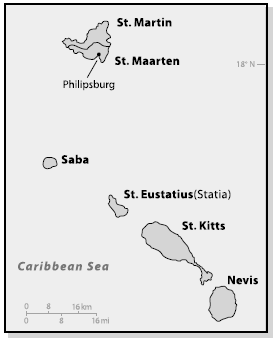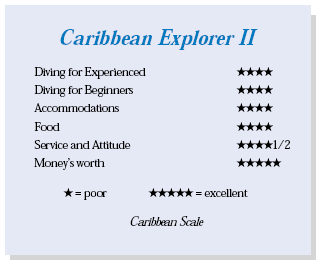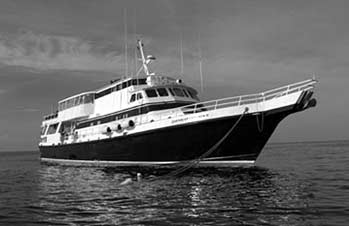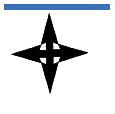Caribbean Explorer II, Saba, Statia, St. KittsContents of this Issue: Caribbean Explorer II, Saba, Statia, St. Kitts Thumbs Down: Short Fills from Lahaina Divers Exercise Before, During, and After Diving Crocodile Hunter in La Paz Rescue Diver Sued for Abandoning Buddy Same Day Switching Between Air and Nitrox Editorial Office: Ben Davison Publisher and Editor Undercurrent 3020 Bridgeway, Suite 102 Sausalito, CA 94965 a steal at $200/night, all inclusive from the March, 2004 issue of Undercurrent
Dear Fellow Diver, The Northeastern Caribbean has two diving gems, Saba and St. Eustatius. Wanting to dive both, while maximizing my underwater time, gave me but one alternative: the Caribbean Explorer II. The original Caribbean Explorer plied these waters for 25 years. The CEX II, refurbished in 2002 with an expanded dive deck, was originally Peter Hughes' Sea Dancer. It is the only live-aboard offering weekly trips in this part of the Caribbean. I boarded the 120-foot craft at St. Maarten's Bobby's Marina to dive three islands: Saba, St. Eustatius, and St. Kitts. The crew waited until 10 p.m. for the last diver to arrive, before departing for the three-hour steam to Saba. The rest of us (Texans, southerners and west coasters, ranging from mid-forties to mid-seventies, with no thong wearers or muscle flexors present) hit the sack, awakening the next morning to a breathtaking view of volcano-peaked Saba. A blowing conch signaled our first briefing. At the camera table, head divemaster Bacchus Freedman told us to "respect this table, keep your stuff off, no crumbs." Only the oxygen analyzer (used by Nitrox divers) was exempt. His safety lectures were long, informative, accurate, and humorous. Yet he strictly enforced boat rules and was as serious as a pontificating professor. Bacchus, good looking and muscular, with Yanni-like locks and a small diamond pierced through his nose, pointed behind him: "this head is the most popular place on the boat -- leave no man-made 'chemicals,' clean up after yourself." Occasionally, impatient divers called back: "let's go diving." Our first dive was at Ladder Labyrinth, where I sifted my hands through the sand of an ancient lava flow, while watching a peacock flounder bury itself. Several green turtles flapped by, and there were lots of red-lipped blennies and several large spotted drum. I pointed out a spotted snake eel to a nearby diver, who took out a slate and jokingly wrote "rattle?" While I was hanging at 15 feet watching moon jellies, a large barracuda devoured a blue tang in a single gulp. Made me wonder how Dory survived. Or Nemo, for that matter. At Torrens Point, after swimming through a dimly lit lava tube, I emerged near the towering rock sheer cliff of Saba. I retreated from the exit, riding the surge while dodging breaking waves to get into deeper water. With the crew's emphasis on safety, it was ironic that a divemaster didn't lead us through the tunnel or offer instructions on how to return. Back on the deck, Tony Cooper refilled my aluminum 80 to 3,000 psi in five minutes from the air and Nitrox banks, then I checked the O2 percentage and recorded my depth and bottom time. Guests could get any mix they wanted up to 32 percent. Divers getting Nitrox-certified started using Nitrox the first afternoon, beginning at 21 percent and building to 32 percent. The crew was strict about buddy diving, no deco diving, using the smart line, descending and ascending on the anchor line, using Cyalume light sticks (available for purchase) or blinking lights at night, group diving when deep or in currents, and no drinking after diving. (The crew recorded us in and out of the water, but despite their thoroughness, they missed checking the air "on" for several divers during the week.) Unaccustomed to so many rules, I asked why -- the standard on every live-aboard, I was told. Not true. Many live-aboards employ a "same day, same ocean" buddy system for experienced divers and photographers. The CEX II captain, Pete Bassell, 30, didn't look old enough to own a driver's license. A likeable Brit, he told us
"there are enough life jackets for each of
you to have three. Eye of the Needle and Diamond Rock are two of Saba's premier dive sites (the only time during the week that we saw a local dive boat). Following CEX II's group practice, they had us enter consecutively "like skydivers." We went hand over hand along a smart line from the boat to the mooring line. The Eye, a stunning pinnacle that tops off in 95 feet of water, is packed with sponges, fans, and whips. In the swift, swirling currents and 100-foot visibility I saw several 6-8 foot reef sharks. While we explored the pinnacle, the three instructors hung in the blue away from the bommie, making sure air divers didn't descend beyond 130 feet and Nitrox divers stayed above 110 feet. While the water was a pleasant 81 degrees, everyone wore lycras or wetsuits, if not for warmth, then to avoid jelly tentacles. The underwater terrain makes Saba's diving deeper. Dives on Statia and St. Kitts were in the 30- to 80-foot range, without walls. The length of the dive was stated as an hour, but especially when group-led the dive was usually 45 to 50 minutes. There were no serious camera buffs onboard, and with four to five dives a day there were no complaints about the shorter dive limits. Before diving Man O'War Shoals, named for a tangle of ships that sank in the shallows, Bacchus warned us about a cave whose entrance was covered with black coral. "Don't enter it. We don't want the coral harmed and you aren't technically equipped." At Tedran and Tent walls (with a night dive on shallower Tent Reef), the pristine walls held spectacular sponges. While I saw many species of fish, only reef and nurse sharks had any size, though a nice school of jacks once circled us during a night dive. The CEX II dive deck has a large camera table; benches have cylinder brackets and individual cubbies underneath. There is a small charging station for cameras and E-6 processing in the photo lab on the lower deck. There are rinse tanks for cameras and masks, plus a wetsuit drying rack. I welcomed the hot shower on the deck and clean towels after a dive. Entry was a stride off the 5-foot-high deck. A diver could remove his gear in the water and climb one of two ladders to the dive deck. The crew was helpful with divers who needed assistance and reserved a place next to the side entry for one diver who had had back surgery. Two 30-foot lines dropped from the stern for mandatory three-minute safety stops. This was the first boat in recent memory that didn't offer drift diving. Bacchus could be overbearing. Once, with a blow of a conch, he jived a Congo dance around the dive camera table to signal a briefing for the Twilight Zone. "You know all divemasters are control freaks." Huh? Some of us thought he could chill a bit. Nonetheless, Twilight Zone would be another guided tour. And the divers groaned. As Bacchus continued, a Zodiac ran through our dive site. He grabbed an air horn to stop the hapless soul and warned him that he was dangerously running his boat through our dive site. We had planned to depart Saba after a land tour, but the immigration official was "out to lunch," and no one could sign off on our departure. So the next morning we took two morning dives. After getting permission to depart, we ate lunch, and the boat fired up for the 90-minute trip to Statia. Statia's port is surrounded by tankers waiting to load or unload crude. Its verdant green volcanic peak looks like a chopped off Mt. St. Helen's. "The diving in Statia is very different. Some of my favorite sites are here," Bacchus told us. St. Eustatius Marine Park rules require that a ranger dive with the group, so ranger Pete Esteban led us on our two dives. "No gloves, no touching," he said. "If that photograph is so important to you, think of the damage you might cause the reef while you are shooting." Wreck City is where a freighter and tug were destroyed by a 1986 hurricane. Stingrays, one missing a tail, were all over the sand. It was great watching their blinking gills above curious eyes. Mushroom Gardens is "jaw-dropping," said Bacchus, "it's a rock star dive site. It's seafan insanity. Expect a bit of a breeze (current). The pool is open." We descended to find a peacock flounder camouflaged in the sand and two large nurse sharks resting in a sand channel. The landscape consists of winding mini-canyons filled with schools of southern sennet and plenty of tropicals. A great dive. Onboard the CEX II, the upper-level, air-conditioned, compact open-air salon has three dining booths enclosed by a plastic awning. A small entertainment area has a video, CD, and DVD player. Reclining deck chairs line the aft deck. Four windowed cabins, each configured differently, are on the dive deck. A few had bunks, others had twin or double beds, all had an ensuite bath and shower. They were tastefully furnished and clean. The lower deck had six cabins, plus crew quarters. Compared to some live-aboards, my cabin on the main deck seemed spacious, but the minimal space between the bunks made it impossible to sit in my cabin. Only a strong, agile person could have climbed into my upper bunk. Vanity lights over the sink and mirror provided great illumination for inserting contact lenses. Reversing the head of the bed away from the door and next to the window gave me access to a hanging basket that served as a night stand, but it meant relinquishing the night light. My cabin door was not well sealed, but it never got noisy because this crowd retired early. While the ship holds 18 passengers, this trip carried only 10, so none of the singles had to share a cabin. With only 10 mouths to feed, the crew gave us an extra, much-appreciated 30 minutes to sleep, but it made for a hectic day. After a 7 a.m. wake-up and breakfast, the first dive was at 8:15, followed by others at 10:15, 1:15 and 4 p.m. There was a 6 p.m. dusk dive or a 7:15 night dive. Dinner was always served at 6 p.m. Chef Merhay Tesfa Endrias, a cheerful and relaxed soul, was amazing, though it was his first week on the job. He provided "al dente" vegetables, subtle seasonings, and attractively garnished plates. He served to-die-for barbecue ribs. Salmon and chicken were cooked to perfection, all some of the best live-aboard food I've tasted. Breakfast was cooked to order, anything you wanted. Lunch was ordinary food: a sandwich, tuna salad, and plain ol' hot dogs and hamburgers. The killer -- calorie-wise -- was his baking. Hot carrot cake offered after a morning dive, tiramisu for dinner, sundaes or banana splits. And the service was excellent. Premium alcohol, wine, and beer were complimentary. With fives dives a day, there isn't much time to drink; one wonders why more boats don't offer a have-a-drink-on-us policy. The young crew of seven (three dive instructors), while all new to the CEX II, were well experienced. Bacchus and Amy (also a nurse) recently transferred from the Tahiti Aggressor. They said that after the Iraq War the Polynesians voided their American visas and hired locals. Engineer Tony Cooper came from the Junk, a live-aboard operating in the Andaman Sea. They all took good care of us. The rooms and baths were cleaned daily and vacuumed every few days. While bed linens weren't changed during the week, towels were. Yolande Strydon usually finished her housekeeping chores before the first dive. Nightly turn-down service included a mini-Snickers or Hershey bar resting on the pillow. Yolande frequently led night dives, and her keen eye for critters was much appreciated by the group. At Statia, five
moorings, which had
been purchased and
maintained by diving
fees, had been stolen.
We couldn't anchor, so
we made the hour passage
to St. Kitts a
day earlier than
planned, a disappointment
given Statia's
good diving. Macro lovers and wreck divers liked St. Kitts' diving (visibility was about 50 feet). We dived the River Toire, a ship that sank during a hurricane in the 1980s, and the Talata, where encrusted concrete cylinders extruding rotted wood were thought to have been used by slaves to crush sugar cane. During the final dive here, we were greeted by a 5-foot moray swimming in open water -- and an octopus, found by Captain Pete on the sand, pulsated flashing colors before swimming off to his crevice in the wreck, as if to say goodbye as we ascended to the boat. So the CEX II gave me what I wanted: plenty of dives aboard a pretty good boat with a competent crew. Of course, the Caribbean is not the Indian Ocean and because the CEX II sticks to standard moorings, the diving doesn't differ from what one can expect from land-based operations on the islands it visits. Nevertheless, for the price, convenience, and bottom time, it's hard to beat. -- G.S. P.S.: Both Saba and St. Eustatius have excellent land-based dive operations that reach the good diving. Check the Chapbook for plenty of information about Saba accommodations and operations. For St. Eustatius, which is visited by fewer than 1,000 divers a year, refer to the January 2003 issue of Undercurrent and my full review. With decent accommodations and good food, plus very good Caribbean diving, Statia is hard to beat. Online members can access the issue at Undercurrent or you can order it for $5 by e-mailing sales@undercurrent.org. -- Ben
|

I want to get all the stories! Tell me how I can become an Undercurrent Online Member and get online access to all the articles of Undercurrent as well as thousands of first hand reports on dive operations world-wide
| Home | Online Members Area | My Account |
Login
|
Join
|
| Travel Index |
Dive Resort & Liveaboard Reviews
|
Featured Reports
|
Recent
Issues
|
Back Issues
|
|
Dive Gear
Index
|
Health/Safety Index
|
Environment & Misc.
Index
|
Seasonal Planner
|
Blogs
|
Free Articles
|
Book Picks
|
News
|
|
Special Offers
|
RSS
|
FAQ
|
About Us
|
Contact Us
|
Links
|
3020 Bridgeway, Ste 102, Sausalito, Ca 94965
All rights reserved.

 I am anal when it comes
to safety." Pete gave a stern warning about
using illicit drugs. "Get rid of them now.
I will not risk losing my 13,000 pound captain's
license." When he once smelled marijuana
and the passenger wouldn't 'fess up,
he called the French Coast Guard and had the
guy jailed. "When they board a ship searching
for drugs, they carry machine guns." In
looking at the passengers aboard, my guess
was that a joint had not hit their lips
since John Lennon died.
I am anal when it comes
to safety." Pete gave a stern warning about
using illicit drugs. "Get rid of them now.
I will not risk losing my 13,000 pound captain's
license." When he once smelled marijuana
and the passenger wouldn't 'fess up,
he called the French Coast Guard and had the
guy jailed. "When they board a ship searching
for drugs, they carry machine guns." In
looking at the passengers aboard, my guess
was that a joint had not hit their lips
since John Lennon died.  I
was told that the islands sit on the edge of the open Atlantic, making currents unpredictable, and the boat's one
small dinghy couldn't handle the
group. Then get a larger dinghy.
These currents were made for drifting.
During the week, no one got swept past
the stern in a current, so they
weren't required to put out the "dingy
of shame," as they called it.
I
was told that the islands sit on the edge of the open Atlantic, making currents unpredictable, and the boat's one
small dinghy couldn't handle the
group. Then get a larger dinghy.
These currents were made for drifting.
During the week, no one got swept past
the stern in a current, so they
weren't required to put out the "dingy
of shame," as they called it. Anchors
Aweigh, an encrusted
lava flow, holds a
collection of 30
anchors dating back to
the 1800s. One large,
century-old anchor has
river rocks scattered
nearby, thought to be
used as ballast on a
sunken slave ship.
Here I could escape the group and explore on my own. A
school of barracuda hovered; yellowheaded
jawfish peeked out of sandy
holes. A golden high hat, similar to
the spotted drum, ducked behind a
rock. A baby hawksbill turtle
appeared oblivious to me. After two
dives, it was an hour boat ride to the
next mooring. I find diving most
Caribbean sites twice a major flaw.
But that's the drill. Dive boats are
required to use established moorings
at Saba and Statia, and not all can
handle a boat the size of the CEX II.
The pattern continued at St. Kitts.
Anchors
Aweigh, an encrusted
lava flow, holds a
collection of 30
anchors dating back to
the 1800s. One large,
century-old anchor has
river rocks scattered
nearby, thought to be
used as ballast on a
sunken slave ship.
Here I could escape the group and explore on my own. A
school of barracuda hovered; yellowheaded
jawfish peeked out of sandy
holes. A golden high hat, similar to
the spotted drum, ducked behind a
rock. A baby hawksbill turtle
appeared oblivious to me. After two
dives, it was an hour boat ride to the
next mooring. I find diving most
Caribbean sites twice a major flaw.
But that's the drill. Dive boats are
required to use established moorings
at Saba and Statia, and not all can
handle a boat the size of the CEX II.
The pattern continued at St. Kitts.  Diver's Compass: CEX II alternates departure (either St. Maarten
or St. Kitts) each week. ... The climate in December was sunny
(80 degrees) and dry except for "grains," or short, strong downpours.
... Water was 81 degrees. ... The cost of a seven-night
trip is $1,145 to $1,495/person, depending on season and cabin,
plus a $3 a dive charge in Saba and a $15 yearly fee in Statia.
... There are no dive fees in St. Kitts. ... Half the group got
Nitrox certified onboard during the week. ... Owner Clay
McArdle, landlocked in Mills, WY, moved the original Explorer to Providenciales in
the Turks & Caicos and also operates the Nimrod Explorer in Cairns, Australia. ...
Rental gear was available, including a Nikonos. ... When a guest had trouble with
fins, the boat lent him a pair; they made every effort to try to repair a flooded
camera. ... T-shirts cost up in the $20s, and a chamois jacket about $85. There
were also kiddy items, fish ID books, and other knick-knacks. ... Contact them at
Diver's Compass: CEX II alternates departure (either St. Maarten
or St. Kitts) each week. ... The climate in December was sunny
(80 degrees) and dry except for "grains," or short, strong downpours.
... Water was 81 degrees. ... The cost of a seven-night
trip is $1,145 to $1,495/person, depending on season and cabin,
plus a $3 a dive charge in Saba and a $15 yearly fee in Statia.
... There are no dive fees in St. Kitts. ... Half the group got
Nitrox certified onboard during the week. ... Owner Clay
McArdle, landlocked in Mills, WY, moved the original Explorer to Providenciales in
the Turks & Caicos and also operates the Nimrod Explorer in Cairns, Australia. ...
Rental gear was available, including a Nikonos. ... When a guest had trouble with
fins, the boat lent him a pair; they made every effort to try to repair a flooded
camera. ... T-shirts cost up in the $20s, and a chamois jacket about $85. There
were also kiddy items, fish ID books, and other knick-knacks. ... Contact them at
